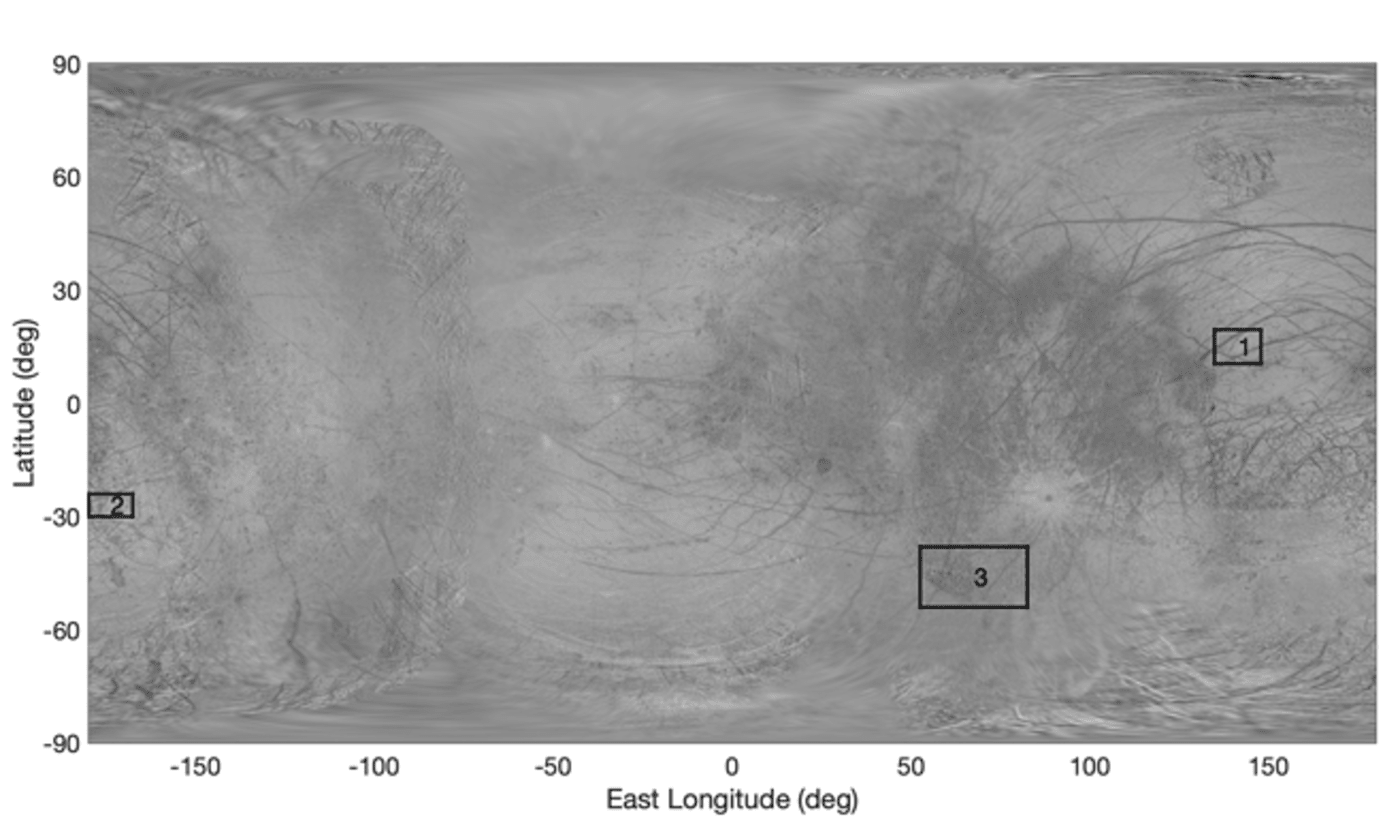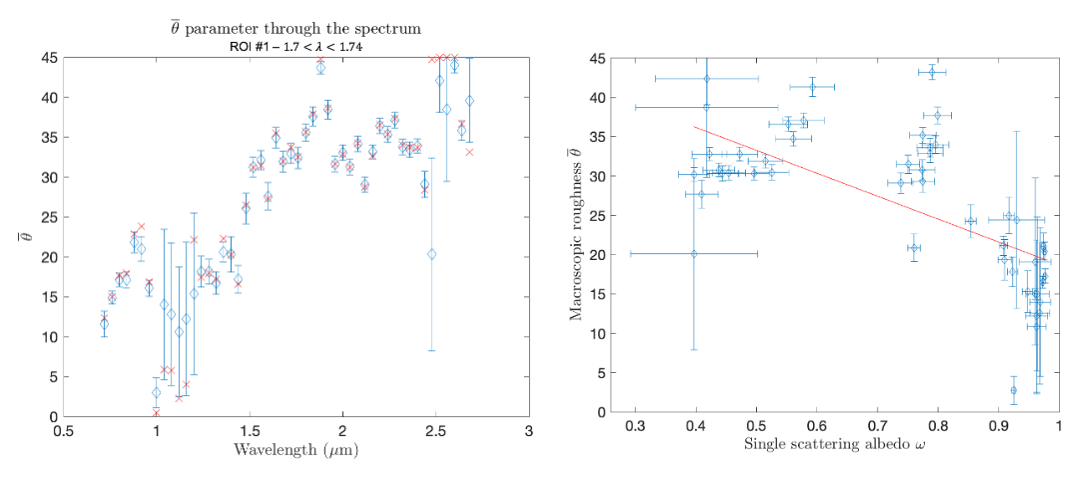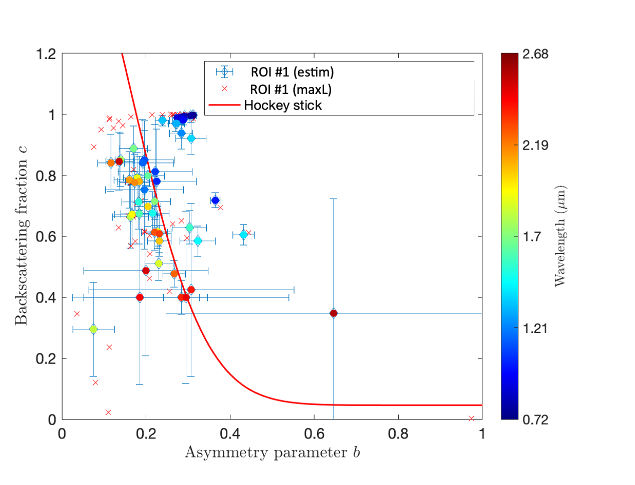Spectrophotometry of selected regions of Europa - Comparing apples to apples
- 1NASA Jet Propulsion Laboratory, United States of America (ines.belgacem@jpl.nasa.gov)
- 2ESA, ESAC, Madrid, Spain
Europa is an important target in the search for habitability [1, 2, 3]. Currently there are two missions bound to the Jovian system: NASA's Europa Clipper [4], which will study Europa as a possible habitable environment, and ESA's JUpiter ICy moons Explorer (JUICE) [5] that will study the Jovian system as a whole and focus on Ganymede. This study is a reanalysis of the data from Galileo's Near Infrared Mapping Spectrometer (NIMS) [6] to better understand the photometric behavior of Europa's surface in preparation for future exploration. We derived Hapke photometric parameters [7, 8, 9, 10, 11] for 3 regions of Europa between 0.7 𝜇m and 2.6 𝜇m and analyzed their spectral evolution. We used a Bayseian approach similar to past studies [12, 13]. This abstract describes the results of region of interest #1 on fig. 1 as it yielded the most robust estimation of photometric parameters and is representative of the spectral trends we observed.

Fig. 1: Map of Europa (credit: Björn Jonssón) highlighting the regions of interest in this study.
Dataset
Calibrated and georeferenced data cubes (g-cubes) archived in the PDS Imaging Node have been ingested in a MySQL database[14]. Each pixel includes information about its calibrated radiance factor values for all the wavelengths measured, along with its relevant geometric and geographic information, including longitude, latitude, azimuth, incidence, emission and phase angles. This tool allows for a comprehensive view of the dataset and quick exploration to assess the spatial and angular coverage available for our study. We extracted all available pixels falling in selected regions of interest that cover ground resolutions between 2 km/pixel and 320 km/pixel.
Results
We found that the macroscopic roughness is anti-correlated with the single scattering albedo (fig. 2) and tends to decrease at shorter wavelengths and higher albedos. Although we found different possible explanations for this, we favor this result being due to multiple scattering partially illuminating primary shadows, resulting in an artificially lower value of roughness at higher albedos, which in Europa's case happens at shorter wavelengths.
The main implication is that great care should be taken when comparing terrains with different albedos and making conclusions about their other physical properties above a certain brightness. The same rationale is valid for viewing the same area at different wavelengths where the reflectance varies. In particular, on high albedo surfaces or at wavelengths with a particularly high reflectance, photometric analyzes and Hapke modeling will most probably underestimate the value of the macroscopic roughness. However, for sufficiently low albedos surfaces (under about 0.3 normal reflectance according to [15]) where multiple scattering is not an issue, the use of the macroscopic roughness in the Hapke model is unaffected. This should be the case of most darker regions on Europa in the blue filter (centered at 0.48 microns) [16].

Fig. 2: Left: Retrieved values of the macroscopic roughness θ for a range of wavelengths for ROI #1. Right: Variation of the macroscopic roughness θ vs. the single scattering albedo ω.
This study finds that ROI #1 tends to scatter light in a large variety of directions (low b, large scattering lobe) at shorter wavelengths, a result that suggests more complex particles such as agglomerates of particles with a high density of internal scatterers [17, 11]. At longer wavelengths, there is progressively more forward scattering (see fig. 3), which could mean a lower density of internal scatterers interacting with the incoming light. However, this work cannot exclude the possibility of that behavior being the result of chemical compounds.

Fig. 3: Retrieved values of the backscattering fraction b vs the asymmetry parameter c for ROI #1 superimposed with the hockey stick relation [11].
Future work
Future work will include comparing the trends identified in this work to different icy planetary bodies across the solar system as well evaluating the wavelength dependencies of other models, in preparation for NASA’s Europa Clipper.
Acknowledgements
This work was supported by the Europa Clipper Project. The research described in this manuscript was carried out at the Jet Propulsion Laboratory, California Institute of Technology, under a contract with the National Aeronautics and Space Administration. Our team would also like to acknowledge the work from the Galileo NIMS team and the PDS imaging node for making these data publicly available.
References:
[1] Pappalardo, R. T. et al. (1999) JGR: Planets. [2] Carr, M. H. et al. (1998) Nature. [3] Vance, S. D. et al. (2018) JGR: Planets, 123. [4] Pappalardo, R. T. et al. (accepted) SSR. [5] Grasset, O. et al. (2012) Planetary and Space Science. [6] Carlson et al. (1992) SSR. [7]Hapke (1984) Icarus. [8] Hapke (1986) Icarus. [9] Hapke (2002) Icarus. [10] Hapke (2008) Icarus. [11] Hapke (2012) Icarus. [12] Belgacem et al. (2020) Icarus. [13] Belgacem et al. (2022) Icarus. [14] Cornet et al. (2022) EPSC. [15] Veverka et al. (198) Icarus. [16] Johnson et al. (1983) JGR. [17] A. McGuire, A. and Hapke, B. (1995) Icarus.
How to cite: Belgacem, I., Cornet, T., and Buratti, B. J.: Spectrophotometry of selected regions of Europa - Comparing apples to apples, Europlanet Science Congress 2024, Berlin, Germany, 8–13 Sep 2024, EPSC2024-265, https://doi.org/10.5194/epsc2024-265, 2024.